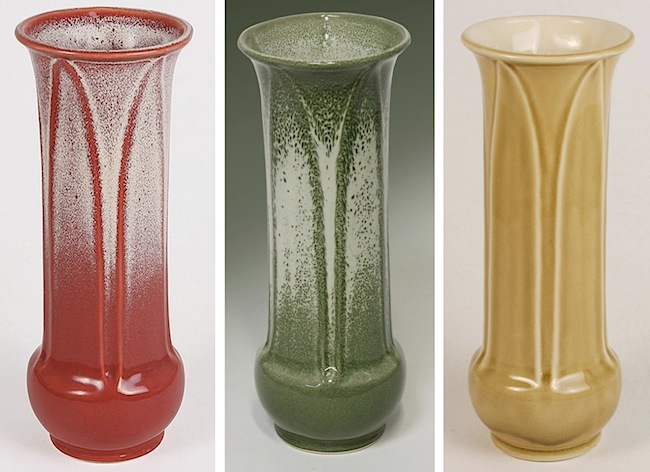
Some of us look at an eight-place setting of fine porcelain china and see a family gathered for Thanksgiving dinner. Gazing upon a curvaceous piece of art pottery, we immediately picture it up on the mantel, lit by a pin spot and casting seductive shadows on the wall. But when Jim Robinson of Rookwood Pottery looks at a ceramic mixing bowl, a stoneware jug, or even a single piece of architectural tile, he sees rocks.
“You don’t formulate colors and clay bodies and all that stuff just for the intellectual challenge.”
“Oh, I’m absolutely crackers for geology,” Robinson confirms when we spoke recently. “I was reading John McPhee once,” he says of the famous “New Yorker” writer, “where he talks about how the movement of plate tectonics forces rocks down into subduction zones. When that happens, most common minerals like feldspar melt, but McPhee calls out this one particular mineral compound for its heat resistance—zirconium silicate, what us potters know as zircopax or zircon. Even after being fried inside the earth’s crust for millions of years, zircon doesn’t lose the memory of what it was, which is why potters use zircon to make a glaze opaque. It’s actually zircon’s ability to take the heat that makes it an effective opacifier. So, as I’m reading my McPhee, I’m thinking, ‘Zircon, you dog!’”
Such epiphanies explain why being an amateur geologist is probably not a bad avocation for a glaze chemist, Robinson’s job title for the past seven years at Rookwood in Ohio, and his passion for four decades before that as a “clayworker” (his term) in Oregon. That said, “glaze chemist” doesn’t begin to describe the full extent of Robinson’s role at Rookwood. Sure, he’s developed hundreds of glazes in his relatively brief time there, but he also designs vases, formulates recipes for the clay itself, and generally pitches in when things go haywire. “I work my butt off,” he says with undisguised pride.

Top: The Angelica Vase was first produced in 1917 by Rookwood designer Albert Munson. At some point, the mold for the vase was lost, and it would have remained so had a Rookwood collector not showed up at the company’s Cincinnati headquarters one day with a vintage vase and its mold under his arm. His goal was to commission Rookwood to make a new one for his wife, Angela. The company did that, and the vase now bears her name. Above: Rookwood glaze chemist Jim Robinson measuring out a glaze recipe.
In fact, it was Robinson’s work ethic that caught Rookwood’s eye in 2006, when the company rose from its financial collapse of 1967. For almost 40 years, people who loved American decorative ceramics had been forced to talk about Rookwood in the past tense. The folks who were trying to resurrect Rookwood needed a team that could simultaneously build upon Rookwood’s then-125-year legacy of art pottery and architectural tile while pushing it into the 21st century.
That give-and-take between past and present is actually a pretty good description of Robinson’s career, during which he was equally acclaimed for his coil-built ceramic sculptures of polar bears as his functional serving platters. No doubt Rookwood found much to admire in Robinson’s aesthetics, but the venerable company probably paid more attention to his reputation as a perfectionist when it came to the composition of his clay and glazes. To experience Robinson’s attention to detail for yourself, read his 1992 article for “Studio Potter” magazine titled “Revival Fires: Another Face of Shino,” in which he describes six different types of the centuries-old Japanese glazing technique and shares recipes for about 50 different Shinos.
Robinson’s ability to work with one foot in the past and the other in the present was exactly what Rookwood was looking for. What they might not have expected, though, is that the foot Robinson had planted in the past was sunk into what geologists call “deep time“—the time, essentially, that it takes to move not just mountains but whole continents.

This 6 1/2-inch tall vase featuring blue nudes was designed by Rookwood ceramist Jens Jensen in 1933. (Via Mark Mussio, Humler & Nolan)
His interest in rocks and geology came early. “When I was in high school in 1967,” he says, “I had a great professor, Richard Tremblay, who got into plate tectonics just as it was emerging. He explained to us how the surface of the planet was skidding around, powered by these upwellings of magma, and how when two plates encountered each other, one went down into the subduction zone and the other sprouted mountains. Well, I came seriously unglued when I heard that, and I’ve been reading about rocks and geology ever since.”
To put it mildly, this love of rocks and minerals has completely colored Robinson’s world. “I’m looking out a window now at a brick building,” he tells me as we are chatting over the phone. “Every brick building is made out of different clays. Some are kind of taupe gray. Some are really deep rust. Every brick is different because each comes out of a different hole in the ground. That just blows my mind.” More particularly, Robinson’s romance with stone has had a profound impact on his work as a ceramist. “Once you get an image in your mind of the earth and how active it is,” he says, “you start to put two and two together. You think, ‘That’s where the minerals are.’”
One mineral Robinson knows well is feldspar, two of whose alkalis, potash and soda, are common ingredients in clay. Potash and soda are easy to find, their ubiquity nothing more—or less—than the product of deep time. “The reason why a clay industry developed here in the Midwest is in large part because of the Appalachian Mountains,” Robinson begins. “When feldspar weathers, it turns into kaolin, the stuff porcelain is made of. The potash, soda, and calcium that’s locked up in the feldspar erodes out, running all the way to the sea—that’s why the sea is salty. However, the clay ingredients erode out and settle in places like Georgia and Kentucky, Tennessee and Ohio. The hard rock like pyrophyllite and quartz remain in the mountains. It’s the coolest damn thing.”

This rare Rookwood vase by Kataro Shirayamadani from 1901 features electroplated copper on the flowers and stems. (Via Mark Mussio, Humler & Nolan)
This sort of geological behavior is obviously consistent, whether you live in the shadow of the Appalachians or the Cascades, as Robinson did during his decades in Oregon. But although Robinson’s knowledge of glaze chemistry was transferable when he moved from Oregon to Ohio in 2009, he faced a sizable learning curve when it came to Rookwood’s most prevalent technique, the practice of making just about any form of decorative pottery in a plaster mold. To give you an idea of how important moldmaking has been to Rookwood, some 3,300 of the company’s most historic forms still reside in the company’s archive, and that’s well short of the total number of molds Rookwood has made and used since it was founded in 1880.
“I never used molds,” Robinson says of his 40 years as a clayworker, “so I had to learn a lot about them.” One of the keys to getting moldmaking right, he learned, is water. “When you hand-throw a pot, the clay body is about 25 percent water,” Robinson explains. “Water brings clay to life; it makes it malleable. But if you’re going to put a chunk of clay in, say, a plaster press to make a tile, the clay body should be less than 20 percent water, usually about 15 percent, somewhere in there. It’s so stiff, you couldn’t do a thing with it as a potter, but when it’s in a press coming down at 90 tons per square inch, 15 percent is perfect.”
The clay used in other types of Rookwood molds is much wetter, roughly the consistency of pancake batter. This clay is not formulated to be pressed. Instead it’s designed to be poured, like liquid chocolate into a mold shaped like an Easter bunny.

Though he’s best known for the hundreds of glazes he’s developed in his seven years at Rookwood, glaze chemist Jim Robinson also makes time to design vases and formulate recipes for clay bodies.
“The interior of a plaster mold is the shape of the piece you want,” Robinson continues. “The liquid ‘slip,’ as it’s called, is poured directly into the mold and filled to the tippy top. It’s a mixture of clay, feldspar, quartz, and a few other ingredients, including deflocculants, which are compounds that make the slip loose and fluid, so you don’t have to use too much water. When you pour this liquid into the mold, the slip that comes in contact with the inside of the mold’s plaster wall absorbs some of its water, causing it to thicken at the edges. In fact, so much water is leeched from the slip that you sometimes have to top off the mold with more slip. Then, after waiting a prescribed amount of time, depending on the size of the piece, you turn the whole shooting match over and pour out the slip in the middle that hasn’t hardened.” After giving the clay on the edges of the mold time to dry, the mold is opened to reveal the piece.
“Every brick is different because each comes out of a different hole in the ground.”
If water is the first element Robinson and Rookwood potters must manage, fire is the second. “I used to fire everything in a gas kiln at a high temperature, cone 10,” he says, “which is 2,300 degrees Fahrenheit. Sometimes I’d do a reduction firing, which is just restricting the amount of oxygen getting into the kiln. That’s how you produce those beautiful celadon blue and green glazes, the copper reds, and the Shinos, which are these thick, fat, viscous glazes that get their wonderful warm tone from the iron in the clay body itself. Here at Rookwood, though, we fire in electric kilns, so there’s no reduction, and we’re at cone 6, which is only 2,165 degrees.”
In general, before a piece of ceramics is glazed it is bisque-fired, during which the unglazed piece is heated to around 1,900 degrees Fahrenheit. “That stabilizes the clay so the tiles or pots or whatever you’re making can be moved around, cleaned up, and stored safely without damaging them,” Robinson says. “Then the piece is glazed and fired at a hotter temperature. That’s the standard, two-fire procedure, although we’ve done some single-fire ware, where we take, say, a thick tile, let it dry, glaze it, and then fire it in a single cycle. We don’t do that very often, though.”

Current Rookwood designer Dan Dutton’s “Tadpole & Dragonfly” vase is based on a shape from 1900, mold number 907B.
In either case, whether he’s firing at cone 6 or 10, Robinson is looking for a clay body and glaze that “get along with each other,” as he puts it. “A kiln is basically a reactor,” he says. “Its heat loosens, in many cases, the bonds that hold all these crystalline materials together. Then, as the kiln cools down, they recombine. This is what’s happening in the clay body. At the same time, on the surface of the piece where the glaze has been applied, all hell is breaking loose. The glaze goes into an almost glassy state, so you’ve got to have an overall structure that won’t collapse as the minerals in the glaze fuse with compatible minerals in the clay body.” In the glaze, those minerals often include Robinson’s old friend zircon, which, thanks to its molecular integrity at high temperatures, keeps a glaze’s color opaque.
Minerals, water, heat—these, then, are the essential ingredients of ceramics, at Rookwood or anywhere else. But the reason why places like Rookwood need glaze chemists like Robinson is because when these seemingly simple variables are combined, the results can be vexing. Take the way a clay body expands as it’s heated and contracts as it’s cooled: The minerals in a glaze on the surface of a clay body are going to do the same thing, so Robinson needs to make sure that the expansion and contraction of the clay body is in “agreement” with the expansion and contraction of the glaze.
Unless that’s not the effect he’s after. “If the glaze contracts more than the clay body as it cools, it snaps and makes these little fine lines called ‘crazing.’ Actually, if you’re trying to achieve that characteristic, it’s called ‘crackle’—crazing is what happens when things go wrong. To prevent crazing, when you design a glaze you look at all the oxides and other elements that are in it so that you can figure out beforehand the temperature it will melt at and what its relative expansion will be. I used to do all that by longhand,” he adds, “but now I use a computer program designed by Lawrence Ewing down in New Zealand.”

The 1909 Rookwood vase by Kataro Shirayamadani is almost 9 inches tall and features a scene of birch trees in the moonlight. (Via Mark Mussio, Humler & Nolan)
Before Robinson’s friendly Kiwi came on the scene, glaze chemists relied on the work of a German named Hermann Seger, who, in the 1860s, came up with his indispensable three-part ratio for glazes, which Seger determined would always contain some combination of silica, flux, and aluminum oxide.
“On the far-right end of the temperature scale is silica, which melts at a really high temperature,” Robinson says. “To make silica melt at a lower temperature you add fluxes to it, or what we’ve come to know as ‘flux ingredients.’ These are all straight off the periodic chart—potassium, sodium, calcium, magnesium, strontium, and barium.” In the bad old days, lead was also on that list, a powerful and actually very beautiful flux, according to Robinson. Alas, it was also incredibly toxic.
Rounding out the three-part ratio is aluminum oxide, which basically keeps a glaze from running down the sides of a vase as it’s being fired. “The three-part ratio is the common language of all ceramists,” Robinson says. “If I see a beautiful transparent glaze in Japan, all I need to say to its maker is, ‘What’s the formula?’ If the silica in the glaze was contributed via a local stone, I can calculate the ratio at a molecular level, which will fulfill all the properties of the glaze but allow me to use my own local stone. I can also determine, in advance, if the glaze will be glossy or matte, as well as its color.”

Between December of 1885 and December of 1886, Chicago pharmacist Dr. William S. Christopher conducted a series of glaze and clay-body experiments at the behest of Rookwood founder Maria Longworth Nichols Storer. This is a photocopy of Dr. Christopher’s work, which is still used as a reference document by current Rookwood glaze chemist Jim Robinson.
At Rookwood, Robinson has more than a century’s worth of glaze ratios to draw upon. The oldest glaze recipe book he has access to was produced by a Chicago pharmacist named Dr. William S. Christopher, who was brought to Cincinnati between December of 1885 and December of 1886 by Rookwood founder Maria Longworth Nichols Storer to conduct a series of glaze and clay-body experiments. Occasionally, Robinson refers to his photocopy of this early document, but his more frequent source of glaze wisdom is found in a half-dozen paperboard boxes from the early 1940s, each of which is filled with 3-by-5-inch index cards. The recipes on these cards date from 1899 to 1940, and were typed by Monsignor Cletus Miller—more likely, his secretary—when the Archdiocese of Cincinnati owned the Rookwood property.
“I can go down into our archive and look at those whenever I want,” Robinson says of the cards. “They’re written in a kind of code: ‘F’ for feldspar, ‘Z’ for zinc, ‘K’ for kaolin. What I usually do is copy down the notes on the cards, convert them into molecular formulas, and then plug in my formulas and the materials that are available to me. A whole bunch of the materials used by the old Rookwood are now completely gone,” he adds, “but the chemistry is constant, so you can extrapolate from that.”
For example, even though feldspar is one of the most common minerals on earth, the particular flavors of feldspar, if you will, that Rookwood used in the late 19th and early 20th centuries have been mined out. “A feldspar pit actually needs to be quite pristine and free of contamination from other stones,” Robinson says. “I’m not sure what the source of Rookwood’s first feldspar was, but I think one of the spars they used in the past came from New York. There were many, many feldspar pits around the United States. That’s the material that’s probably changed the most.”

Glaze chemist Jim Robinson routinely refers to the glaze recipes kept in these paperboard boxes from the early 1940s. Each is filled typed Rookwood glaze recipes from 1899 to 1940.
In some cases, the minerals favored by Rookwood potters in Ohio came from even farther afield. “One of the early Rookwood potters,” Robinson says, “favored this very specific feldspathic type of stone from England called Cornwall stone. I actually used to work with it at cone 10 when I was potting out in Oregon. Eventually I found out that ‘ST’ in the index cards was shorthand for Cornwall stone. That was a real revelation. It’s still in production all of these years later. For certain applications, there’s simply no stone quite like it.”
Nor have materials been the only things to change at Rookwood. “We fire at 2,165 to 2,195 degrees, somewhere in that range,” Robinson says, “but to the best of my knowledge, prior to 1967, Rookwood never fired at temperatures above 2,100 degrees. Because they fired a little bit cooler than we do, their glazes need more flux than the ones I’m making now for firing at cone 6. But I can extrapolate for that.”
As Rookwood’s glaze chemist, though, Robinson’s main focus is color, which is, after all, the characteristic most people associate with the word “glaze.” “Since I’ve been at Rookwood,” Robinson says, “I’ve learned more about color than I had in my previous 40 years in ceramics. Most of the colors I was going for in Oregon at cone 10 were very subtle. Here, we work with a full, wide range of colors.”

When collaborating at Rookwood, a frequent occurrence, glaze chemist Jim Robinson will prepare a triaxial study so his colleagues can see the color variations in a given glaze recipe at a glance.
To explore this range, Robinson will frequently create what he calls a “triaxial study,” which is essentially a pyramid of ceramic color swatches, so that the differences in the colors created using a particular glaze recipe can be seen at a glance. At the top of the pyramid is red, which Robinson blends with mineral-based colorants so that it shades through several examples of orange until reaching full yellow. That sequence forms the left side of the pyramid, and then the same process is repeated on the right, although the goal there is to move through various shades of purple on the way to blue. “Of course, between the yellow and blue at the bottom are all the greens,” he says. “So you got your primaries and secondaries, all in one place.”
For Robinson, the most interesting colors are just about always in the middle. “If you look at the bottom row,” he says, “you’ll see greens that’ll blow you out of a room. They’re so strong and so bright. But if you go up just one level, they’re softer, more muted and complex. The only difference between the two is a tiny bit of red.”
Although Robinson has been making triaxial studies for years, they have proven especially useful at Rookwood, where collaboration with designers, tile makers, and the ceramists who mix and pour slip into molds is a critical part of the process. “I’ll put these triaxial studies in front of my colleagues, and they’ll say ‘Oh, we can use that color right there, but not this one,’ or ‘Could you make that color a little stronger?’ Working off the triaxials, I know how to get where they want to go, whether it’s a crystalline surface, a matte finish, a gloss—pretty much anything they want.”

All this Rookwood tile, installed in the lobby of the Monroe Building in Chicago, had been hidden by sheetrock walls and a drop ceiling, until it was recently restored. Rookwood glaze chemist Jim Robinson and a colleague named John Williams created new tiles for the restoration, matching not just colors but their variations.
Recently, that boast was put to the test when Robinson and a Rookwood colleague named John Williams (who’s since moved on to Motawi Tileworks in Ann Arbor, Michigan) were asked to match the Rookwood glaze colors and clay bodies that fill the lobby of the Monroe Building in downtown Chicago. Back in 1912, when Rookwood produced the architectural tile for the building’s entrance and its dramatic vaulted ceiling, people like architect Frank Lloyd Wright had offices upstairs. But by 2006, when the building was purchased by its current owners, who wanted to restore the historic structure to its former glory, most of Rookwood’s work was hidden behind sheetrock and drop ceilings installed during misguided attempts at modernization in the 1950s and ’60s. “The tile floors were still in use,” Robinson sighs, “but they were pretty worn out.”
As we now know, the glazes and tiles used at the Monroe were made from materials that cannot be precisely duplicated anymore, while the plaster forms the tiles were pressed into no longer exist. To make the project even more complicated, the new owners of the Monroe were not interested in a uniform upgrade, in which all the replacement tiles looked brand spanking new. They wanted Robinson and Williams to match the subtle variations in the tile colors and surfaces, even down to the crazing.
Finding a solution, Robinson says, took a combination of “glaze chemistry and a massive amount of hair pulling. For the tile floor alone, we developed four different beiges and as many shades of black. It was intense, and there were lots of times when John and I would walk into the building and think, ‘Oh my god, why did we ever sign up for this?’ But today, I can’t think of anything I’m more proud of. I mean, you don’t formulate colors and clay bodies and all that stuff just for the intellectual challenge, although that can definitely be thrilling. You do it because your work is going to become a part of people’s lives. You do it,” the glaze chemist and geology buff says, “because you get to make art.”
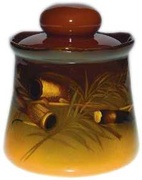
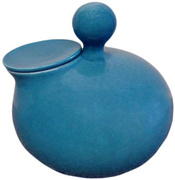 Red Wing Beyond the Crock: Larry Roschen on the Stoneware Legend’s Dinnerware
Red Wing Beyond the Crock: Larry Roschen on the Stoneware Legend’s Dinnerware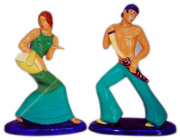
 Riley Humler Explains the Importance of Rookwood Art Pottery
Riley Humler Explains the Importance of Rookwood Art Pottery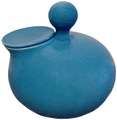 Red Wing Beyond the Crock: Larry Roschen on the Stoneware Legend’s Dinnerware
Red Wing Beyond the Crock: Larry Roschen on the Stoneware Legend’s Dinnerware Cowan Art Pottery of the Art Deco Era
Cowan Art Pottery of the Art Deco Era Rookwood Art PotteryFounded in 1880 by Maria Longworth Nichols, Rookwood pottery is a favorite …
Rookwood Art PotteryFounded in 1880 by Maria Longworth Nichols, Rookwood pottery is a favorite … PotteryThe term “art pottery” is a largely Western designation for traditional cer…
PotteryThe term “art pottery” is a largely Western designation for traditional cer… Mari Tepper: Laying it on the Line
Mari Tepper: Laying it on the Line Nice Ice: Valerie Hammond on the Genteel Charm of Vintage Canadian Costume Jewelry
Nice Ice: Valerie Hammond on the Genteel Charm of Vintage Canadian Costume Jewelry How Jim Heimann Got Crazy for California Architecture
How Jim Heimann Got Crazy for California Architecture Modernist Man: Jock Peters May Be the Most Influential Architect You've Never Heard Of
Modernist Man: Jock Peters May Be the Most Influential Architect You've Never Heard Of Meet Cute: Were Kokeshi Dolls the Models for Hello Kitty, Pokemon, and Be@rbrick?
Meet Cute: Were Kokeshi Dolls the Models for Hello Kitty, Pokemon, and Be@rbrick? When the King of Comedy Posters Set His Surreal Sights on the World of Rock 'n' Roll
When the King of Comedy Posters Set His Surreal Sights on the World of Rock 'n' Roll How One Artist Makes New Art From Old Coloring Books and Found Photos
How One Artist Makes New Art From Old Coloring Books and Found Photos Say Cheese! How Bad Photography Has Changed Our Definition of Good Pictures
Say Cheese! How Bad Photography Has Changed Our Definition of Good Pictures Middle Earthenware: One Family's Quest to Reclaim Its Place in British Pottery History
Middle Earthenware: One Family's Quest to Reclaim Its Place in British Pottery History Fancy Fowl: How an Evil Sea Captain and a Beloved Queen Made the World Crave KFC
Fancy Fowl: How an Evil Sea Captain and a Beloved Queen Made the World Crave KFC
Hello Jim Robison from Medford OR ! We are one on Jim’s many clients. How is Rookwood back in Ohio? Are you making any pottery yourself?
We miss you back in Oregon.
Good luck
Jim,
I’ve just read the wonderful article about you. I too love Zircon, wear a bit. My rock collection days are long over, but I so appreciate what you continue to do with bits of earth. The self portrait pot you gifted me many moons ago, remains atop my side board. Each day, as I walk by the piece, I say “hello”. I’ve retired from attempting to repair the world, to my garden, banty hens, books and paints. I hope this note finds its way to you. Good thoughts, Robin